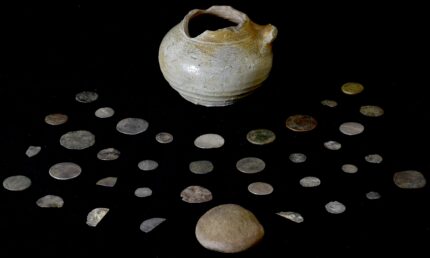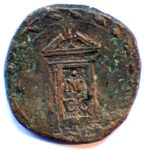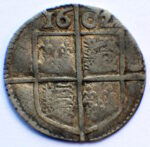A hoard of coins that may have been cached by clan chief Alasdair Ruadh ‘Maclain’ MacDonald just before he was killed in the Glencoe Massacre in 1692 has been discovered under the fireplace at “the summerhouse of Maclain” site in Glencoe.
 The summerhouse was believed to have been a hunting lodge or feasting hall used by Maclain during his five decades as clan chief. The University of Glasgow excavated the site this August. Archaeology student Lucy Ankers found the hoard underneath the remains of the grand stone fireplace. It was a ceramic pot containing silver and bronze coins dating from the late 16th century to the 1680s. Most of them were minted by British rulers (Elizabeth I, James VI of Scotland/James I of Britain, Charles I, the Commonwealth, Charles II), but there was also a bronze coin of Philip IV of Spain, a brass coin of Louis XIII of France and a rare quattrino of Pope Clement VIII.
The summerhouse was believed to have been a hunting lodge or feasting hall used by Maclain during his five decades as clan chief. The University of Glasgow excavated the site this August. Archaeology student Lucy Ankers found the hoard underneath the remains of the grand stone fireplace. It was a ceramic pot containing silver and bronze coins dating from the late 16th century to the 1680s. Most of them were minted by British rulers (Elizabeth I, James VI of Scotland/James I of Britain, Charles I, the Commonwealth, Charles II), but there was also a bronze coin of Philip IV of Spain, a brass coin of Louis XIII of France and a rare quattrino of Pope Clement VIII.
 The dating of the coins strongly suggests they were buried at the time of the massacre. Maclain was known to have traveled internationally and could have picked up coins in the Papal States, Spain, France and the Spanish Netherlands.
The dating of the coins strongly suggests they were buried at the time of the massacre. Maclain was known to have traveled internationally and could have picked up coins in the Papal States, Spain, France and the Spanish Netherlands.
Maclain was the chief of the Glencoe MacDonalds, a clan loyal to the former King James VII of Scotland and II of England, deposed by William III in the Glorious Revolution of 1688. The Jacobite clans in the Highlands rose against William III in 1689 and were defeated. The king demanded they take an oath of allegiance to him by January 1st, 1692, or else be declared traitors. The MacDonalds waited for permission from James before taking the oath and while they did swear allegiance to the new king, by the time they did so it was January 6th and Secretary of State Lord Stair took the opportunity to make a bloody example of the Glencoe MacDonalds.
 On February 13th, 1692, troops under the command of Captain Robert Campbell of Glenlyon (the Campbell clan and the MacDonalds had a long-standing feud) descended upon Glencoe with orders to kill anyone under the age of 70. MacLain was the first to be killed. Then dozens more men, women and children were put the sword. Estimates vary from 30 to more than 80 dead.
On February 13th, 1692, troops under the command of Captain Robert Campbell of Glenlyon (the Campbell clan and the MacDonalds had a long-standing feud) descended upon Glencoe with orders to kill anyone under the age of 70. MacLain was the first to be killed. Then dozens more men, women and children were put the sword. Estimates vary from 30 to more than 80 dead.
The shocking brutality was subject to international condemnation and a Scottish Parliamentary Commission of Inquiry was formed to investigate the massacre as a “murder under trust,” ie, killing in cold blood after a surrender had been arranged or hospitality accepted. Nothing happened to anyone involved in the slaughter as a consequence of the inquiry.
Historians believe whoever buried the coins may have been killed during the massacre, since they did not return for them.
Other finds from the structure included musket and fowling shot, a gun flint and a powder measure, as well as pottery from England, Germany and the Netherlands and the remains of a grand slab floor.
[…]Historians speculated the coins may have been buried two weeks later – on the morning of the massacre. Survivors ran up a side glen during a blizzard, and may have encountered the property.
Dr Michael Given, the co-director of the University of Glasgow’s archaeological project in Glencoe, said: “These exciting finds give us a rare glimpse of a single, dramatic event. Here’s what seems an ordinary rural house, but it has a grand fireplace, impressive floor slabs, and exotic pottery imported from the Netherlands and Germany.